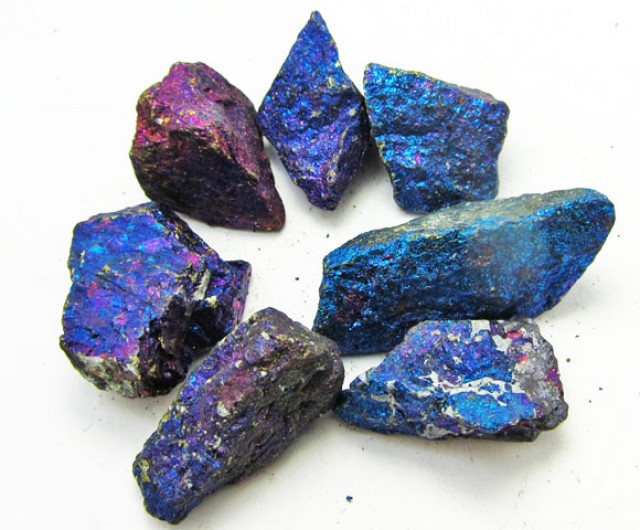
斑铜矿:特性、含义、价值等
 斑铜矿是自然界最色彩斑斓的宝石之一!它甚至被昵称为“孔雀矿”,因为它拥有迷人的虹彩光泽——类似于孔雀羽毛上展现的五彩缤纷。
斑铜矿是自然界最色彩斑斓的宝石之一!它甚至被昵称为“孔雀矿”,因为它拥有迷人的虹彩光泽——类似于孔雀羽毛上展现的五彩缤纷。
斑铜矿是稀有矿物吗?一点也不。这种石头是一种含铜矿物,也是一种重要的铜矿石,大量存在于火成岩、变质岩和沉积岩中。
许多人认为斑铜矿是一种人造晶体。这种说法源于人们用化学物质处理黄铜矿,使其看起来像斑铜矿,以便卖家可以将其宣传为“孔雀矿”(稍后会详细介绍)。
由于矿石质地柔软,斑铜矿首饰十分罕见。斑铜矿主要被矿物收藏家和水晶治疗师用作标本。
就疗愈而言,斑铜矿有什么用途?斑铜矿被认为是象征幸福和好运的宝石。人们相信它能将负能量转化为正能量,使人身心受益。
想了解更多关于这种常见却被低估的宝石吗?继续阅读我们的《斑铜矿宝石指南》,了解斑铜矿的特性、含义、历史、价值等信息。

关于斑铜石
与许多宝石一样,“孔雀石”并非斑铜矿的唯一别名。其他别名包括:
泛红的铜
赤铁矿
孔雀铜
紫铜矿
杂色铜
为了本指南的目的,我们在提及这种矿物时将坚持使用“斑铜矿”。
虽然斑铜矿并非传统的黄道十二宫石,但据说这种水晶对射手座的人有益。射手座热爱冒险、探索和旅行,斑铜矿能保护射手座免受冒险途中的负面情绪影响,帮助他们将梦想变为现实。
在命理学中,斑铜矿与数字二和四产生共鸣。
与赤铁矿一样,斑铜矿也出现在日本热门动漫迷你剧《琉璃之国》中,是一种活泼、无性别的宝石角色,拥有操纵冰的力量。
那么,如何判断你的水晶是不是斑铜矿呢?它的矿物特征会告诉你一切你需要知道的信息。
斑铜矿规格和特性
斑铜矿并非天生就带有虹彩。它最初呈黄铜黄色(由于含有铜)或暗银色(由于铁含量较高)。这种矿物在暴露于空气和湿气后会迅速失去光泽,呈现出璀璨的金属彩虹般的虹彩。
斑铜矿含金吗?斑铜矿的含金量比黄铜矿高,但它的主要成分是铜和铁。作为铜矿石,斑铜矿的铜含量较高,约为63%。
虽然斑铜矿通常呈现正交对称性,但其晶体通常呈立方体、八面体或十二面体,且表面通常呈曲面或粗糙状。此外,斑铜矿通常致密、呈颗粒状或块状,在风化过程中容易转变为辉铜矿和其他铜矿物。
当加热到 350℃ (662℉) 以上时,斑铜矿也会产生磁性。
以下是斑铜矿矿物数据的概述:
化学式:Cu5FeS4
矿物家族:硫化物
成分:硫化铜铁
莫氏硬度:3至3.5
颜色:铜红色至黄褐色至灰色或灰黑色;失去光泽时呈现彩虹色。
晶体结构:正交
光泽: 金属光泽
透明度:不透明
密度:4.9至5.3
孪生:{111} 渗透孪生
解理:{111} 差/不明显
断口:不规则至贝壳状
韧性:脆
条痕:深灰色至黑色
发光:非荧光
多色性:微弱但明显
斑铜矿经常与其他矿物混淆,例如磁黄铁矿、镍矿,尤其是黄铜矿。

斑铜矿与黄铜矿
孔雀矿是斑铜矿、黄铜矿,还是两者兼有?
斑铜矿和黄铜矿具有几乎相同的化学结构,但它们并不是同一种矿。
首先,与斑铜矿不同,黄铜矿通常不会失去光泽。即使有光泽,与斑铜矿相比,光泽也非常弱。
黄铜矿的其他显著物理特性包括其浅黄铜色泽、金属光泽和比重(4.1 至 4.3)。黄铜矿的硬度也高于斑铜矿, 莫氏硬度为 3.5 至 4。
黄铜矿与黄铁矿或黄金的相似度更高。黄铜矿只有在加入酸后才会变成蓝紫色,类似于彩虹色斑铜矿。
这并不是说斑铜矿不存在不同的种类。
斑铜矿的种类
斑铜矿有三种变体:
半斑铜矿
波兰前苏台德单斜区 Zechstein 铜矿床的一种,其特征是铁含量不足 50%。
季斑铜矿
波兰前苏台德单斜区 Zechstein 铜矿床的一种,其特征是铁含量缺 75%。
含银斑铜矿
一种含银的斑铜矿。
既然您已经是识别斑铜矿的专家了,那么让我们继续了解历史吧。

斑铜矿的意义和历史
在大多数早期宝石学文献中,斑铜矿并未被列为一种独特的矿物。然而,它作为贵金属(例如金、银,尤其是铜)的矿石的存在,表明人类与这种矿物的接触已有数千年。此外,人类很可能还将其与各种未被记录下来的形而上学特性联系起来。
这种矿物最早于1725年在现今捷克共和国的一个铜矿中被发现。然而,斑铜矿在一个多世纪的时间里一直没有正式的名称。直到1845年,为了纪念特兰西瓦尼亚矿物学家伊格纳兹·冯·博恩(Ignaz Von Born),它才被正式命名为斑铜矿。
博恩生前曾是共济会和其他几个秘密社团的杰出成员。其中一个秘密社团是维也纳光明会,由反对迷信和政府及宗教权力滥用的知识分子和进步人士组成。
历史?搞定。接下来,是时候深入形而上学了!
图片来源:James St. John | Flickr
斑铜矿的治疗功效
大多数水晶都可以用作疗愈石,滋养你的身体、情绪或精神。斑铜矿的能量可以同时滋养这三种状态。
这种矿物质被认为有助于改善你的现在和未来。它能够将坏事转化为好事,这体现在你生命的各个层面——为你未来的任何旅程奠定坚实的基础。
首先,让我们看看斑铜矿晶体对身体有何益处。
身体康复
人们相信斑铜矿是治疗身体疾病(尤其是下半身疾病)的极佳晶体。水晶治疗师经常用它来强身健体,促进儿童健康成长。
如果您患有眩晕症或经常感到身体失去平衡,斑铜矿可以帮助您恢复平衡状态。
据说这种石头还可以帮助缓解发烧、肌肉痉挛和血液循环。
情绪疗愈
斑铜矿的快乐、理智能量会激励你采取行动,改善你的现状和未来。它能让你保持积极心态,而不是被负面观点所拖累。
你是否曾有过很大的梦想,但感觉它们不可能实现?
这种水晶能消除情感障碍和自我阻碍,让你成为你一直想成为的人。斑铜矿能让你思路清晰,找到巧妙的解决方案,并专注于解决问题,而不是纠结于问题本身。
精神疗愈
斑铜矿的精神意义与心灵的宁静相关。这种矿物能帮助你保持脚踏实地,尤其是在处理与道德相关的问题时。它鼓励你将长期持有的个人价值观与新的信息相结合,让你的行为既受理智的指引,又受情感的引导。
将斑铜矿视为您的道德指南针的图腾,帮助您找到稳定的道德中心,以便您可以从那里作为起点做出合乎逻辑和公正的决定。
许多水晶治疗师还建议使用斑铜矿作为脉轮石,以激活和调整身体上的所有脉轮(或能量中心)。
那么,斑铜矿是如何分级的呢?

斑铜矿宝石特性
每颗宝石都有其独特的特征,专家在评估其价值时会评估这些特征。对于斑铜矿,他们通常会评估颜色、切工和克拉重量。
颜色
斑铜矿的颜色很独特,它开始是一种颜色,但结束的时候却又是另一种颜色。
这种矿物在最新鲜的天然状态下呈黄铜黄色或暗沉的银黑色,通常看起来非常普通。然而,氧化作用会使其虹彩般的光泽显露出来。
斑铜矿的色彩越鲜艳,其价值就越高。
当斑铜矿中含有其他矿物(如黄铜矿或黄铁矿等)时,价格就会上涨。
切
由于斑铜矿性质脆弱, 因此刻面切割的宝石很少见。
这种矿物更适合制作凸圆形宝石。然而,由于其储量丰富,除了切割之外,它们并没有什么其他重要价值。
斑铜矿通常以原石或未切割的形式出售。价格取决于标本的大小和独特性。
克拉重量和尺寸
斑铜矿通常以块状或浸染状金属颗粒和斑块的形式存在于硫化物矿床中。标本大小不一,从几盎司到几磅不等。
凸圆形宝石也可能很大,长达几英寸,因为矿脉中的块状材料呈大块状。
治疗
就像卖家会对其他宝石进行强化,使它们看起来像斑铜矿一样,斑铜矿本身也可以用酸处理,以增强其天然的、彩虹般的光泽。
由于这种矿物易碎,切割提取并非易事。那么,斑铜矿最初是如何形成的,又在哪里形成的呢?

斑铜矿的起源和来源
斑铜矿主要与黄铜矿、黄铁矿、白铁矿和石英等矿物一起形成于热液铜矿床中。它也与贫硅侵入火成岩、伟晶岩脉和接触变质带一起形成。
当在铜矿床中发现斑铜矿时,斑铜矿被用作铜矿石。
从地理上看,斑铜矿最常见于哪里?
采矿地点
世界上并不一定只有一个地方被认为是斑铜矿之都。相反,这种矿物分布广泛,在世界各地数千个地方都能找到。
最大、最独特的晶体产于哈萨克斯坦、刚果(扎伊尔)和津巴布韦。在美国,大量的金红石晶体产自亚利桑那州和蒙大拿州。
其他值得注意的地区包括:
澳大利亚
奥地利
加拿大
智利
英格兰
德国
意大利
马达加斯加
墨西哥
摩洛哥
秘鲁
塔斯马尼亚
...仅举几例。
你想花大价钱买一块斑铜矿吗?让我们来看看你的预算。
 图片来源:Rob Lavinsky,iRocks.com – CC-BY-SA-3.0
图片来源:Rob Lavinsky,iRocks.com – CC-BY-SA-3.0
斑铜矿的价格和价值
由于斑铜矿储量丰富,它是一种价格相对实惠的半宝石。然而,更大、更鲜艳的斑铜矿价格会更高。
斑铜矿原石的售价通常在每克0.15美元到0.40美元之间。你也可以找到一些价格较低的斑铜矿,价格约为每克0.05美元到0.10美元。
如果您能找到它们,凸圆形宝石和刻面宝石的价格通常在每克拉 10 至 20 美元之间。
同样,斑铜矿珠宝也很稀有,价格也各不相同。
戒指的售价在 10 至 100 美元之间,有些戒指的售价甚至高达 1300 美元。
每件吊坠的平均价格在 10 至 75 美元之间。
手镯的价格在 15 美元到 100 美元之间。
保持斑铜矿的美丽和能量取决于宝石的保养。
斑铜矿的保养和维护
说到保存斑铜矿,最重要的是记住不要将斑铜矿浸入水中。这种矿物太软,无法长时间浸泡。
清洁斑铜矿时,只需使用软毛刷去除任何污垢或杂质即可。您也可以使用湿布和温和的肥皂。清洁后,请彻底擦干,并将其存放在阴凉干燥处,远离坚硬的矿物。
为了保证斑铜矿的安全,请避免:
在易受冲击的活动中佩戴
使用超声波或蒸汽清洁器
接触刺激性化学品和香料
极端或突然的温度变化
作为一种易碎矿物,您还需要选择具有保护性镶嵌的斑铜矿首饰。
与 Bornite 一起实现您的梦想!
就像孔雀在展示其色彩斑斓的羽毛时,其看似普通的外观就会发生变化一样,斑铜矿的普通外观也会随着其迷人的虹彩开始显现而变得完全不同。
它的美丽与快乐、充满希望的能量相伴,相信它会激励你无畏地走向目标。有了斑铜石的陪伴,任何障碍都无所不能。你准备好驾驭它的光辉,追逐不可能了吗?
搜索Gemstone Encyclopedia
最新的文章
彩虹格纹日光石是一种长石,由于内部含有各种包裹体,呈现出三种绚丽的光学效应。它绚丽多彩的光泽和格纹图案使其成为收藏家梦寐以求的珍宝!
12th Jan 2026
文章分类
How To's is where you will find helpful articles from gem Rock Auctions on how to cut gemstones, select gemstones and buy gemstones.
9文章数
